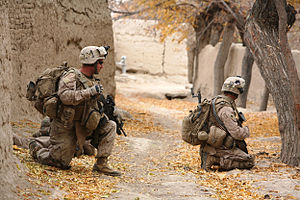Operation Cobra's Anger

The Operation Cobra's Anger (German: Operation Wrath of Cobra) is an airborne operation of the US Marine Corps with an Afghan support unit in the province of Helmand in the area of the valley Nawzad . The aim of the operation, which began on December 4, 2009, is to disrupt the supply and communication lines of Taliban groups .
Beginning of the airborne operation
On the morning of December 4, 2009, the operation commanded by Lt. Col. Martin Wetterauer began with units of the 3rd Battalion 4th Marines in a first wave of 300 men and 150 Afghan soldiers. A total of up to 1000 men in the US units are to be deployed. The units were using helicopters and special aircraft of type V-22 Osprey flown, the machines of the type V-22 Osprey for the first time were used in Afghanistan. The machines of Marine Medium Tiltrotor Squadron 261 at Marine Corps Air Station in New River, North Carolina, were used . The machines managed to cope with the heights of the combat zone and landed more troops and equipment in the secured area of the city of Nawzad.
British special forces and Danish Leopard 2A5DK battle tanks also supported the operation.
First mission reports
On December 7, the troops reported that they had found hiding places where the Taliban were storing explosives, rifles and machine guns. The day before, US spokesman Major William Pelletier had already mentioned the find north of the Nawzad valley near Changowlak at Camp Leatherneck . US Colonel Wayne Shanks pointed out that this operation is one of 22 similar operations currently under way in Afghanistan. The area of Nawzad is one of the areas that are in the British combat zone of Afghanistan.
Up to sixteen Taliban men are said to have died in fighting with the offensive units. Five Taliban were captured.
Capture and stabilize the city of Nawzad
As reported by Col. Randy Newman , the commanding officer of Marine Regimental Combat Team 7 , the population of the city of Nawzad had fled when the operation began. More than 900 Marines and 150 Afghan soldiers combed the city. There were only a few Taliban fighters in the city who were fought and captured. The US forces took positions in the belt of the settlement area to secure the area.
Use of heavy mine clearance equipment
Heavy clearance equipment was used overland in the Nawzad valley as part of the operation because it was expected that the Taliban forces would set the access roads with large booby traps. Therefore, the 2nd Combat Engineer Battalion deployed the Assault Breacher Vehicle (ABV), which was equipped with the heavy clearance equipment. These pioneer tanks were a new development based on the M1 Abrams , which was only completed in 2007. Several booby traps could be eliminated through the use of the ABV. According to the forces deployed, the ABV has proven itself and served to clear the dreaded booby traps at the beginning of the operation.
Web links
Individual evidence
- ^ Beginning of a US offensive on December 4, 2009 in Helmand Province.
- ↑ Use of V-22 Osprey special aircraft
- ^ David Doyle: M1 Abrams ABV Breacher . In: Tankograd military vehicles . No. 4 . Jochen Vollert, Erlangen 2013, p. 18-25 (English: once more into the Breach Classic Military Vehicle No. 140. Translated by Jochen Vollert).
- ↑ Finding of hiding places of the Taliban on December 7th, 2009
- ↑ Reports of Taliban's losses
- ↑ Capturing and securing the urban area of Nawzad ( Memento of December 17, 2009 in the Internet Archive )
- ↑ Use of heavy clearance equipment with M1 Abrams main battle tanks
